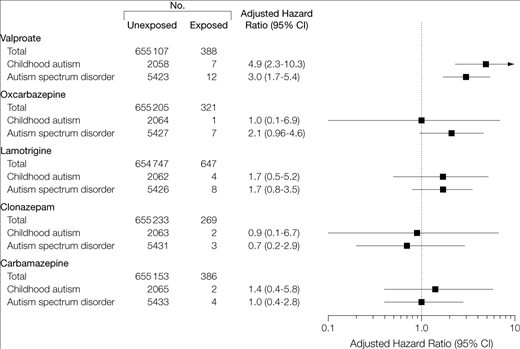JAMA:孕期服用丙戊酸钠增后代自闭症风险
| 导读 |
据4月24日发表在《美国医学会杂志》上的一则研究披露,在妊娠时母亲使用丙戊酸钠(这是一种用于治疗癫痫和其它神经精神疾病的药物)与其后代中自闭症风险的明显增加有关。文章的作者告诫道,这些发现必须要与需要用丙戊酸钠对癫痫进行控制的妇女的治疗裨益进行平衡。
... |

据4月24日发表在《美国医学会杂志》上的一则研究披露,在妊娠时母亲使用丙戊酸钠(这是一种用于治疗癫痫和其它神经精神疾病的药物)与其后代中自闭症风险的明显增加有关。文章的作者告诫道,这些发现必须要与需要用丙戊酸钠对癫痫进行控制的妇女的治疗裨益进行平衡。
根据文章的背景资料:“妊娠期间接触抗癫痫药物与后代的先天性畸形及认知发育延迟有关,但人们对它是否会造成严重的神经精神疾病的风险则知之甚少。”
丹麦奥尔胡斯市奥尔胡斯大学医院的Jakob Christensen, Ph.D.及其同事对母亲在妊娠期间服用丙戊酸钠与其后代发生自闭症谱系疾病及儿童自闭症之间的关系进行了评估。这一基于人口的研究包括了从1996-2006年期间在丹麦的所有活产的孩子。全国性的登记资料被用来确认那些其母亲在怀孕期间接触过丙戊酸钠并且被诊断患有的孩子(自闭症谱系疾病包括儿童自闭症[自闭性疾病]、阿斯伯格综合症、非典型自闭症及其它的或未具体说明的广泛性发育障碍)。研究人员对数据进行了分析并用诸如父母的精神病史、胎龄、出生时体重、性别、先天畸形及产次等可能的混淆因子(即可能会影响结果的因子)对其进行了校正。研究人员从这些孩子出生时就开始对其进行追踪直到这些孩子得到自闭症谱系疾病的诊断之日、或死亡的日期、或移居外国的日期,或时间为2010年12月31日——无论哪个日子先出现。
该分析中包括了从1996年直至2006年中出生的65. 5615万名儿童。这些孩子在追踪结束时的平均年龄为8.8岁。在研究期间,有5437名儿童被诊断患有自闭症谱系疾病,其中包括2067人患有儿童自闭症。研究人员发现了2644个孩子在其母亲妊娠期间接触过抗癫痫药物,其中有508个孩子接触过丙戊酸钠。文章的作者发现,在妊娠期间服用丙戊酸钠与发生自闭症谱系疾病的4.42%的绝对风险及发生儿童自闭症的2.50%的绝对风险有关。
文章的作者写道:“在这一基于人口的群组研究中,与那些怀孕期间没有服用丙戊酸钠的妇女的孩子相比,那些母亲在怀孕期间服用过丙戊酸钠的孩子具有较高的发生自闭症谱系疾病及儿童自闭症的风险。他们的风险也比那些先前服用过丙戊酸钠但在怀孕前停止服用丙戊酸钠的妇女的孩子要高。”
“由于自闭症谱系疾病是对患儿及其家人具有终身影响的严重疾病,因此即使是该风险的适度增加都可能会对健康产生极大的意义。不过,发生自闭症谱系疾病的绝对风险低于5%,这是在向怀孕期妇女提供有关服用丙戊酸钠的咨询服务时需要考虑到的重要内容。”
原文链接:
Prenatal Valproate Exposure and Risk of Autism Spectrum Disorders and Childhood Autism
Importance
Valproate is used for the treatment of epilepsy and other neuropsychological disorders and may be the only treatment option for women of childbearing potential. However, prenatal exposure to valproate may increase the risk of autism.
Objective
To determine whether prenatal exposure to valproate is associated with an increased risk of autism in offspring.
Design, Setting, and Participants
Population-based study of all children born alive in Denmark from 1996 to 2006. National registers were used to identify children exposed to valproate during pregnancy and diagnosed with autism spectrum disorders (childhood autism [autistic disorder], Asperger syndrome, atypical autism, and other or unspecified pervasive developmental disorders). We analyzed the risks associated with all autism spectrum disorders as well as childhood autism. Data were analyzed by Cox regression adjusting for potential confounders (maternal age at conception, paternal age at conception, parental psychiatric history, gestational age, birth weight, sex, congenital malformations, and parity). Children were followed up from birth until the day of autism spectrum disorder diagnosis, death, emigration, or December 31, 2010, whichever came first.
Main Outcomes and Measures
Absolute risk (cumulative incidence) and the hazard ratio (HR) of autism spectrum disorder and childhood autism in children after exposure to valproate in pregnancy.
Results
Of 655 615 children born from 1996 through 2006, 5437 were identified with autism spectrum disorder, including 2067 with childhood autism. The mean age of the children at end of follow-up was 8.84 years (range, 4-14; median, 8.85). The estimated absolute risk after 14 years of follow-up was 1.53% (95% CI, 1.47%-1.58%) for autism spectrum disorder and 0.48% (95% CI, 0.46%-0.51%) for childhood autism. Overall, the 508 children exposed to valproate had an absolute risk of 4.42% (95% CI, 2.59%-7.46%) for autism spectrum disorder (adjusted HR, 2.9 [95% CI, 1.7-4.9]) and an absolute risk of 2.50% (95% CI, 1.30%-4.81%) for childhood autism (adjusted HR, 5.2 [95% CI, 2.7-10.0]). When restricting the cohort to the 6584 children born to women with epilepsy, the absolute risk of autism spectrum disorder among 432 children exposed to valproate was 4.15% (95% CI, 2.20%-7.81%) (adjusted HR, 1.7 [95% CI, 0.9-3.2]), and the absolute risk of childhood autism was 2.95% (95% CI, 1.42%-6.11%) (adjusted HR, 2.9 [95% CI, 1.4-6.0]) vs 2.44% (95% CI, 1.88%-3.16%) for autism spectrum disorder and 1.02% (95% CI, 0.70%-1.49%) for childhood autism among 6152 children not exposed to valproate.
Conclusions and Relevance
Maternal use of valproate during pregnancy was associated with a significantly increased risk of autism spectrum disorder and childhood autism in the offspring, even after adjusting for maternal epilepsy. For women of childbearing potential who use antiepileptic medications, these findings must be balanced against the treatment benefits for women who require valproate for epilepsy control.
关注转化医学网
【转化医学网 新浪微博:@转化医学网】
【转化医学网 公众微信账号:zhuanhuayixue】或扫描二维码关注微信

扫描微信二维码关注
来源:医脉通
 腾讯登录
腾讯登录
还没有人评论,赶快抢个沙发